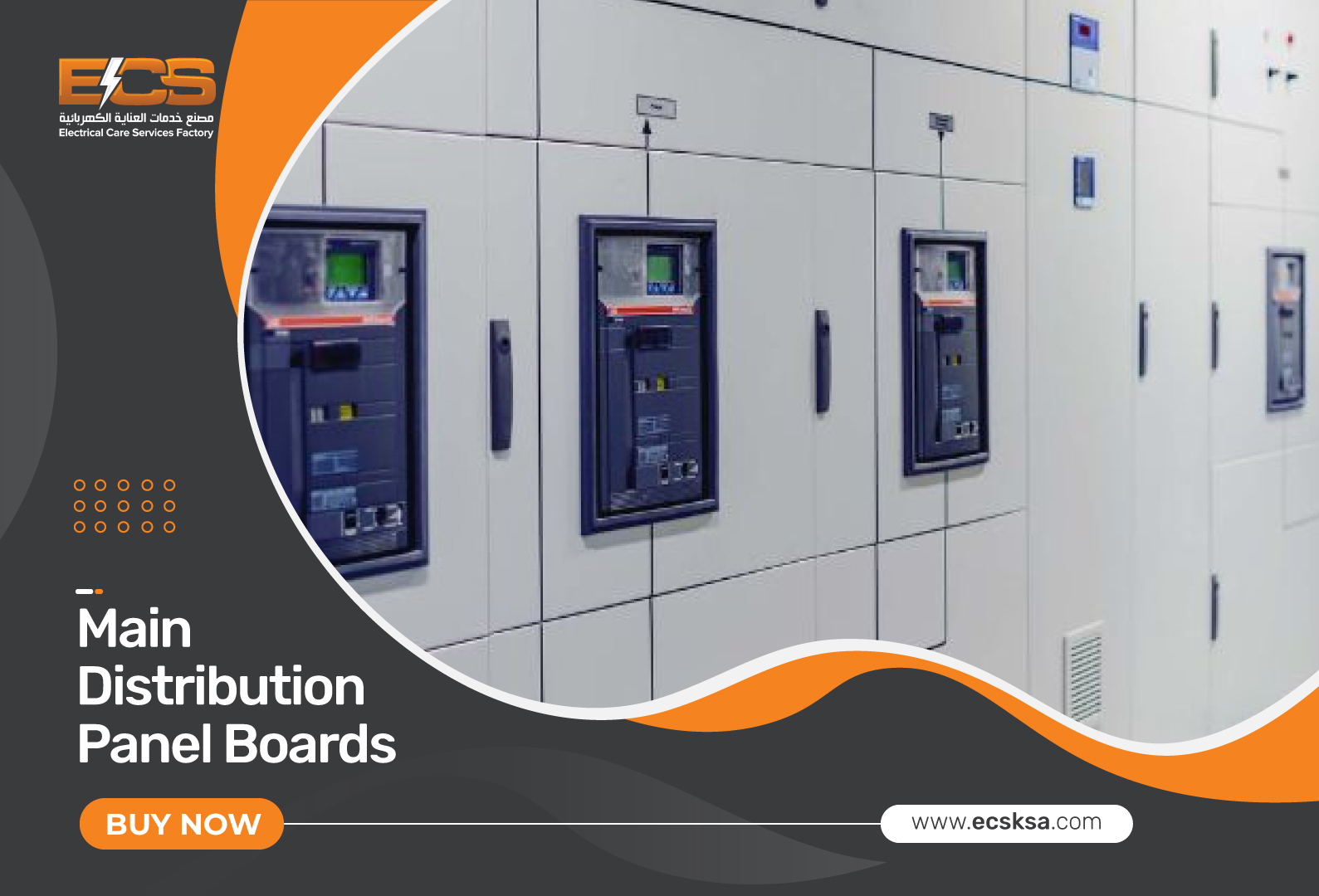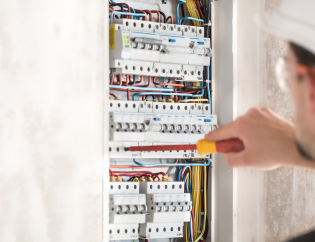You can get an overview of distribution boards from this guide. We’ll briefly go over what they are, how they work, and which kinds of distribution boards are most common.
 What is a Distribution Panel, and How Does it Work?
What is a Distribution Panel, and How Does it Work?
A distribution panel is present in almost every house or business office building. A distribution panel is a location where a huge area, such as a live event, warehouse, or office building, controls its primary electrical source.
Distribution panels come in both big and small sizes. The number of circuits is determined by the requirements of the area that is receiving power.
Typically, a local power plant in your area produces electricity. It is then transmitted into the city’s main power system after being manufactured. As long as you are responsible and pay your electricity bills, your building is free to connect to the main grid.
The same as the city, your building needs to have its electricity grid. If not, you will never be able to plan how your electricity is used. A distribution panel can be useful in this situation. You may regulate energy flow across a whole home by employing one main circuit that divides into multiple smaller circuits.
Simply flip the main switch off whenever you need to turn off all of the electricity in your house or office building, for whatever reason. A distribution panel will often feature a separate switch for situations like these if you need to cut off the electricity in one area or for one large item. Everything is dependent on how the panel is wired.
What are Distribution Boards Used for?
All these variations fundamentally accomplish the same task, whether they are outdoor distribution boards, commercial distribution boards, or specialized lighting distribution boards for huge public venues. They take an electrical connection that is coming in, divide it up, and then reroute it to other sub-circuits.
This makes it possible to control the supply to various locations more precisely and finely and isolate and shut down specific circuits without fully shutting off incoming power.
It also offers extra safety features, usually fuses, breakers, and RCDs, that make using mains power safer. The entire electrical system is better protected from overloads, short circuits, and other risks since each branch circuit has its own safety cut-off.
Basic Functions of a Distribution Panel
-
Power Source for the Entire Set of Equipment
As was briefly noted, the first source of electrical circuits is a distribution panel. Distribution panels operate by connecting together circuits from many sites into a single hub. This enables you to access your home’s entire electrical grid from a single point.
-
Separates the power into separate sources
One main power switch, connected via a distribution panel, controls the power for all circuits. The primary power switch can disable the entire grid momentarily. However, there are also circumstances where you need to manage the power for specific parts of your facility or particular areas.
A distribution panel divides each of the circuits into its own switches as a result. As a result, if you only need to switch off the electricity in one area of your facility, you can do so without cutting off the power to other places that might need it later.
-
Large Buildings and Homes Can Be Powered Up in a Safe and Reliable Way
Powering up your warehouse or office building without a distribution panel would be quite risky. Imagine connecting your local municipality’s electrical grid with hundreds of separate electrical cords running from various sites. Powering up large complexes with a sophisticated electrical system would be a nightmare without distribution panels.
What is the Difference Between a Load Center and a Panel Board?
A load center functions similarly to a power distribution system’s switchboard and a panel board. There is no difference between a panel board and a load center in terms of UL and NEC regulations. Load centers are what the electrical industry refers to as smaller, less expensive panel boards sold mostly in residential applications. In contrast, to load centers, which can only support plug-in breakers, panel boards are frequently deeper than load centers and can accommodate both bolt-on and plug-in circuit breakers.
A maximum current rating of 400 A is allowed for load centers, similarly restricted to 240 V or less and normally given at 100 A or less. A maximum current rating of 1,200 A and up to 600V can both be used with panel boards. Panelboards can be equipped with various optional functions, such as main and branch circuit energy monitoring and integrated surge suppression devices. However, load centers are normally given with no or few alternatives.
What are the Components of a Distribution Panel?
The following parts are frequently found in electrical distribution panels: fuses, linkages, switches, bypass machinery, and residual current detectors (RCDs). Depending on the location and the electrical requirements, electrical distribution boards have different structural and technical features.
Distribution Board Types
Distribution panels for consumer units exist in a number of standard kinds.
- Main switch consumer units are the safest and most reliable protective devices for the incoming main power. Each circuit is completely isolated from the others and has its own RCBO to prevent earth leakage (residual current breaker with overcurrent protection)
- Although they offer less protection than single RCD consumer units, dual RCD consumer units are acceptable for most common purposes. They are made up of two circuit banks, with a pair of RCD (residual current device) breakers protecting each one of them. These provide a strong defense against electrical fires, overheating, and unintentional contact with live wires.
- A greater prevalence of high-integrity consumer units is found in larger structures with numerous sub-circuits branching out from the main supply. They pair extra RCBOs that can be added in a variety of customizable configurations with dual RCD protection.
Other varieties of electrical panel boards and sub-distribution boards, in addition to consumer units, are also commonly used.
Different busbar layouts are available on Type A and Type B distribution boards, as well as differing degrees of compatibility with specific overcurrent protective devices (OCPD). The proper sort of DP to use when installing one in a commercial or industrial setting will rely on compliance with a number of site-specific codes and requirements. You must also take into account environmental considerations, general working circumstances, and any ongoing accessibility requirements.
A smaller breaker panel that serves as a subordinate to a bigger DP is known as a sub-distribution board or sub-board. Once more, this offers better isolation and control over a group of circuit breakers and smaller circuits. An RCD Incomer consumer unit lacking an internal main switch is a typical example. The bigger distribution panel that the sub-board is serving will often have this location.
Power Distribution Board Manufacturing
Power distribution panels were made to be adaptable by their manufacturers. The enclosure can be purchased in three different forms: an empty enclosure, a wired standard unit, or something specially designed to suit the user’s requirements. As long as the boards are connected via a switch disconnector, electrical distribution panels can be used for various portions of a building.
The following parts are frequently found in electrical distribution panels: fuses, linkages, switches, bypass machinery, and residual current detectors (RCDs). Depending on the location and the electrical requirements, electrical distribution boards have different structural and technical features.
The manufacturer makes sure that the fuse prevents overcurrent from passing through the circuitry during the design phase. As long as it stays dry, the distribution panel should be able to support additional cables, fixtures, and wires. It should also be simple to install. It should be protected from corrosion and kept away from flames, especially in areas where food is cooked.
An electrical distribution board’s primary function is to keep a building and its people safe, even if its principal function may be just to distribute electricity throughout a facility. Make sure all safety procedures are followed and there are no accidents when installing an electrical distribution panel.
Conclusion
To have an effective and problem-free electrical distribution system, distribution panel boards are necessary pieces of equipment. You can find all types of panel boards according to your requirement in the market. Also, you can order customized panel boards from ECSKSA. Contact us to learn more about our selection of distribution panel boards
Check out our product pages for quality panel boards for your facility.
Frequently Asked Questions
Why is it called a DB board?
The place in a building where the electrical supply is distributed is called a distribution board (DB). The primary supply cable enters the board, where it is dispersed to the breakers, which in turn distribute it to all of the circuits.
What are the types of distribution boards?
Here are some types of distribution boards:
- Motor Control Centers (MCCs)
- User-Friendly Human Machine Interface (HMI)
- Operator Panels.
- Industrial Hydraulic Control Panels.
- Programmable Logic Controller (PLC) Panels.
- Industrial Hydraulic Control Panels.
What are the five types of distribution systems?
Based on the Wire or Conductor
- Two-wire DC connection of distribution system.
- Two-wire AC connection of distribution system.
- Three-wire DC connection of distribution system.
- Three-wire (delta) AC connection of distribution system.
- Four-wire (star) AC connection of distribution system.
Do you have a question in your mind? If so, make sure to fill out the form below!


